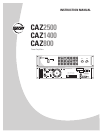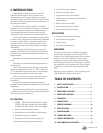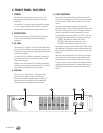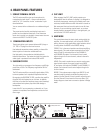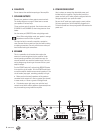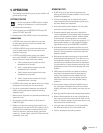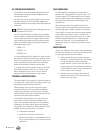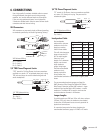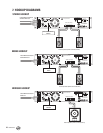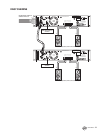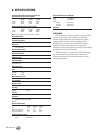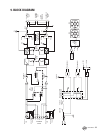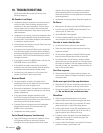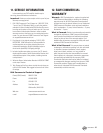
8 – CAZ Series
AC POWER REQUIREMENTS
The amplifi er's power cord should be plugged into an AC
outlet properly confi gured with the voltage required for
your particular model.
Be sure the AC outlet can supply enough current to allow
full power operation of all the amplifi ers plugged into it.
The outlet should be a three-prong socket that matches the
power cord.
WARNING: Bypassing the plug’s safety ground pin can
be dangerous. Don’t do it!
The AC current demand of an amplifi er varies depending
on several factors, including the load impedance, the crest
factor, and the duty cycle of the program material. Under
typical conditions reproducing rock music where musical
peaks are just below clipping, the amplifi ers require the
following average currents.
CAZ800 = 5 A
CAZ1400 = 7 A
CAZ2500 =10 A
It is recommended that a stiff supply of AC power be used
because the amplifi er places high current demands on the
AC line. The more power that is available on the line, the
louder the amplifi er will play and the more peak output
power will be available for cleaner, punchier bass.
If you have more than one amplifi er sharing an AC outlet,
you should avoid turning them all on at the same time.
Rather, sequence them on, one at a time, to prevent
popping the circuit breaker (due to in-rush current).
THERMAL CONSIDERATIONS
The power amplifi er is fan cooled. Air is drawn through the
rear panel vents, to cool down the amplifi er heatsinks, and
then expelled through the front panel vents.
When installing, be sure to allow suffi cient air space
around the front and rear of the amplifi er for adequate
cooling for the heatsinks. Leave at least one rack space
above and below, and at least 6 inches behind and in front
of the chassis to allow proper ventilation.
If the amplifi er should overheat, a thermal switch turns
off the power amplifi er, allowing the heatsink to cool
down. Once the amplifi er has cooled to a safe operating
temperature, the thermal switch resets and reactivates
the amplifi er. If this should occur, identify the cause of the
problem and take corrective action. For example:
• Provide better ventilation
• Install a fan in the rack to move more air
• Make sure the amplifi er is not overloaded with too
low of a load impedance or by a short circuit on the
speaker line
RACK MOUNTING
The CAZ amplifi ers are designed to be mounted
in a
standard rack. They require two rack spaces
(2U = 3.5”).
They also require 15.75” depth inside the rack, including
the rear support brackets. When designing your rack, put
the heavier items at the bottom and the lighter items
toward the top.
Secure the front panel of the amplifi er to the front of
the rack using four screws with soft washers to prevent
scratching the panel. In addition, because of the weight
of the amplifi er, you must secure the rear support brackets
of the amplifi er to the back of the rack. You could use a
support rail or shelf across the back of the rack, or angle
brackets attached between the rear support rails and
the rear rails of the rack. This is recommended for all
components mounted in a rack that is going to be moved
frequently.
MAINTENANCE
Usually, your amplifi er will not require regular maintenance
for normal use. However, you can do several things to keep
it in good operating and cosmetic condition.
• Testing: Periodically test your system for proper
performance. A simple test is to play a CD through
it using well-defi ned, articulate, wide-range
program material. Listen to ensure all drivers are
working properly and for any evidence of distortion
or other extraneous sounds. Test at several volume
levels: very low, normal, and high.
• Cleaning: Use only a clean dry cloth to dust off
and clean the surface. Turn off the power to the
amplifi er while you do this.



